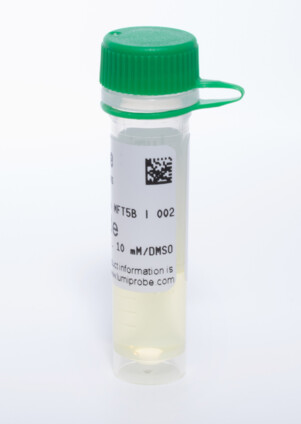- Products
- Reactive dyes
- Dye azides
- FAM azide, 6-isomer
FAM azide, 6-isomer
标签:FAM (Fluorescein), Azides, Fluorescence polarization, Microscopy
| 货号 | 规格 | 价格 | 货期 |
|---|---|---|---|
| 15130 | 100 uL, 10 mM/DMSO | 80.00$ | in stock |
| 35130 | 500 uL, 10 mM/DMSO | 100.00$ | in stock |
| 45130 | 1 mL, 10 mM/DMSO | 150.00$ | in stock |
| A5130 | 1 mg | 80.00$ | in stock |
| B5130 | 5 mg | 100.00$ | in stock |
| C5130 | 10 mg | 150.00$ | in stock |
| D5130 | 25 mg | 295.00$ | 5 days |
| E5130 | 50 mg | 450.00$ | in stock |
| F5130 | 100 mg | 780.00$ | in stock |
FAM (fluorescein) azide. solid and 10 mM solution in DMSO, labeling reagent for Click chemistry.
Pure 6-isomer.
Can replace DyLight 488.
FAM(荧光素)叠氮化物。 固体和 10 mM DMSO 溶液,用于点击化学的标记试剂。
纯 6 异构体。
可替代 DyLight 488。
FAM azide, 6-isomer,FAM 叠氮化物,6-isomer相关产品
Alkyne NHS ester (hexynoic acid NHS ester)
Alkyne NHS ester for the labeling of biomolecules with alkyne group for Copper catalyzed Click chemistry.
炔烃 NHS 酯,用于标记具有炔烃基团的生物分子,用于铜催化的点击化学。
ROX reference dye for qPCR
ROX is a passive reference dye for qPCR amplification. The dye can be used to normalize fluorescence intensity of reporter dye in qPCR.
ROX 是用于 qPCR 扩增的被动参考染料。 该染料可用于标准化 qPCR 中报告染料的荧光强度。
Cyanine5.5 NHS ester
Cyanine5.5 NHS is far-red / near-infrared amine-reactive dye.
Cy5.5 NHS 是远红/近红外胺活性染料。
General properties
| Appearance: | yellowish crystals 淡黄色晶体 |
| Molecular weight: | 458.42 |
| CAS number: | 1386385-76-7 |
| Molecular formula: | C24H18N4O6 |
| Solubility: | soluble in polar organic solvents (DMF, DMSO, alcohols) |
| Quality control: | NMR 1H, HPLC-MS (95%) |
| Storage conditions: | Storage: 24 months after receival at -20°C in the dark. Transportation: at room temperature for up to 3 weeks. Avoid prolonged exposure to light.
储存:收到后 24 个月,在 -20°C 避光保存。 运输:在室温下长达 3 周。 避免长时间暴露在光线下。 干燥。 |
| MSDS: | Download |
| Product specifications |
Spectral properties
| Excitation/absorption maximum, nm: | 494 |
| ε, L⋅mol−1⋅cm−1: | 75000 |
| Emission maximum, nm: | 520 |
| Fluorescence quantum yield: | 0.9 |
| CF260: | 0.20 |
| CF280: | 0.17 |
相关文献:
- Haider, N.; Dutt, P.; van de Kooij, B.; Yaffe, M.B.; Stambolic, V. NEK10 tyrosine phosphorylates p53 and controls its transcriptional activity. bioRxiv, preprint. doi: 10.1101/516971
- Lee, R.; Erstling, J.A.; Hinckley, J.A.; Chapman, D.V.; Wiesner, U.B. Addressing Particle Compositional Heterogeneities in Super-Resolution-Enhanced Live-Cell Ratiometric pH Sensing with Ultrasmall Fluorescent Core–Shell Aluminosilicate Nanoparticles. Advanced Functional Materials, 2021, 31(45), 2106144. doi: 10.1002/adfm.202106144
- Ramey-Ward, A.N.; Su, H.; Salaita, K. Mechanical stimulation of adhesion receptors using light-responsive nanoparticle actuators enhances myogenesis. ACS Applied Materials & Interfaces, 2020, 12(32), 35903–35917. doi: 10.1021/acsami.0c08871
- Reed, S.A.; Brzovic, D.A.; Takasaki, S.S.; Boyko, K.V.; Antos, J.M. Efficient Sortase-Mediated Ligation Using a Common C-Terminal Fusion Tag. Bioconjugate Chemistry, 2020, 31(5), 1463–1473. doi: 10.1021/acs.bioconjchem.0c00156






